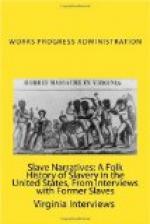Uncle George tells me that he was born May 10, 1860 near Versailles, in Woodford County, Kentucky. His father’s name was Bradford Henderson, who was a slave of Milford Twiman who belonged to the Cleveland family. He does not know where his family came from. There were 21 children including two or three sets of twins. All died while young, except his brothers: Milford, Sam, and Joe; and sisters: Elle and Betsy. All the slaves lived in log cabins and there were about 30 or 40 of them on a plantation of 400 acres. “The cabin I was born in had four rooms, two above and two below. The rooms above were called lofts, and we climbed up a ladder to get to these rooms. We slept on trundle-beds, which were covered with straw ticks. Our covers were made in big patches from old cast-off clothes. When we got up in the morning we shoved the trundle bed back under the big bed. Some boy would ring a great big bell, called the “farm bell” about sunrise. Some went to the stables to look after the horses and mules. Plowing was done with a yoke or oxen. The horses were just used for carriages and to ride. My work was pulling weeds, feeding chickens, and helping to take care of the pigs. Marse Cleveland had a very bad male hog and had to keep him in a pen about 10 feet high. Sometimes he would break out of the pen and it would take all the bulldogs in the county to get him back. I never did earn any money, but worked for my food and clothes. My daddy used to hunt rabbits and possums. I went with him and would ride on his back with my feet in his pockets. He had a dog named Brutus which was a watch dog. My daddy would lay his hat down anywhere in the woods and Brutus would stay by the hat until he would come back. We ate all kinds of wild food, possum, and rabbits baked in a big oven. Minnows were fished from the creeks and fried in hot grease. We ate this with pone corn bread. We had plenty of vegetables to eat. An old negro called “Ole Man Ben” called us to eat. We called him the dinner bell because he would say “Who-e-e, God-dam your blood and guts”.
Out clothes were made of jeens and linsey in winter. In the summer we wore cotton clothes. They gave us shoes at Christmas time. We were measured with sticks. Once I was warming my shoes on a back log on the big fire place, they fell over behind the logs and burnt up. I didn’t marry while on the plantation.
My master and mistress lived in the big brick house of 15 rooms, with two long porches. One below and one below. My mistus was Miss Lucy Elmore before she married. Her children were named Miss Mat, Miss Emma, and Miss Jennie.
I saw the slaves in chains after they were sold. The white folks did not teach us to read and write. We had church on the plantation but we went from one plantation to another to hear preaching. White folks preacher’s name was Reuben Lee, in Versailles. A meeting of the Baptist Church resulted in the first baptizing I ever saw. It was in Mr. Chillers pond. The preacher would say ’I am baptizing you in Mr. Chillers pond because I know he is an honest man’. I can’t remember any funeral.




